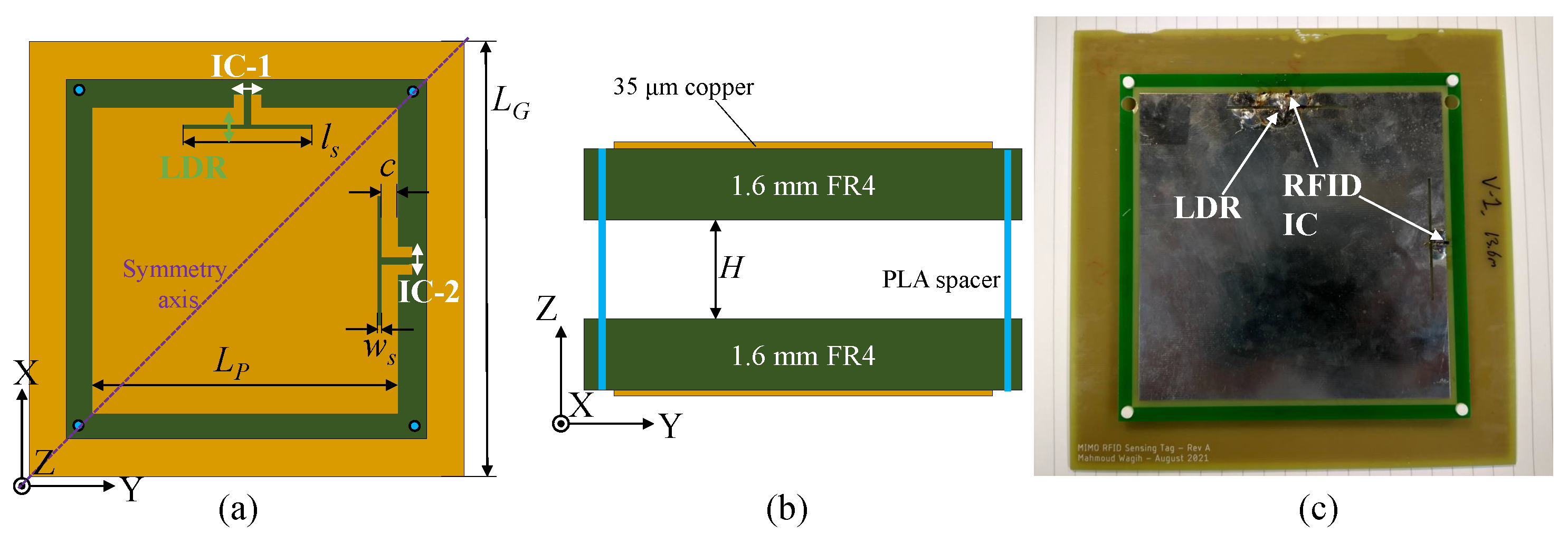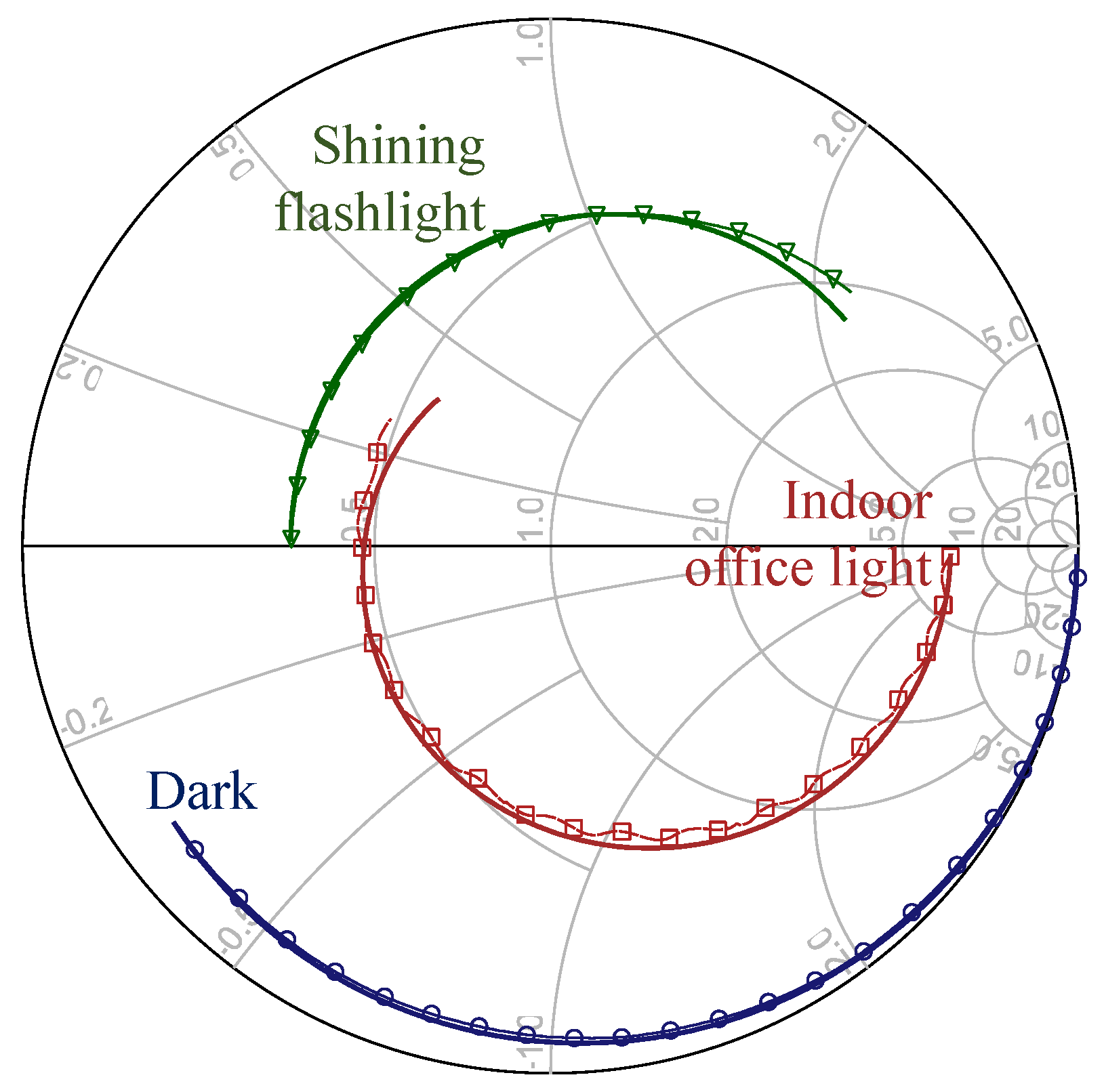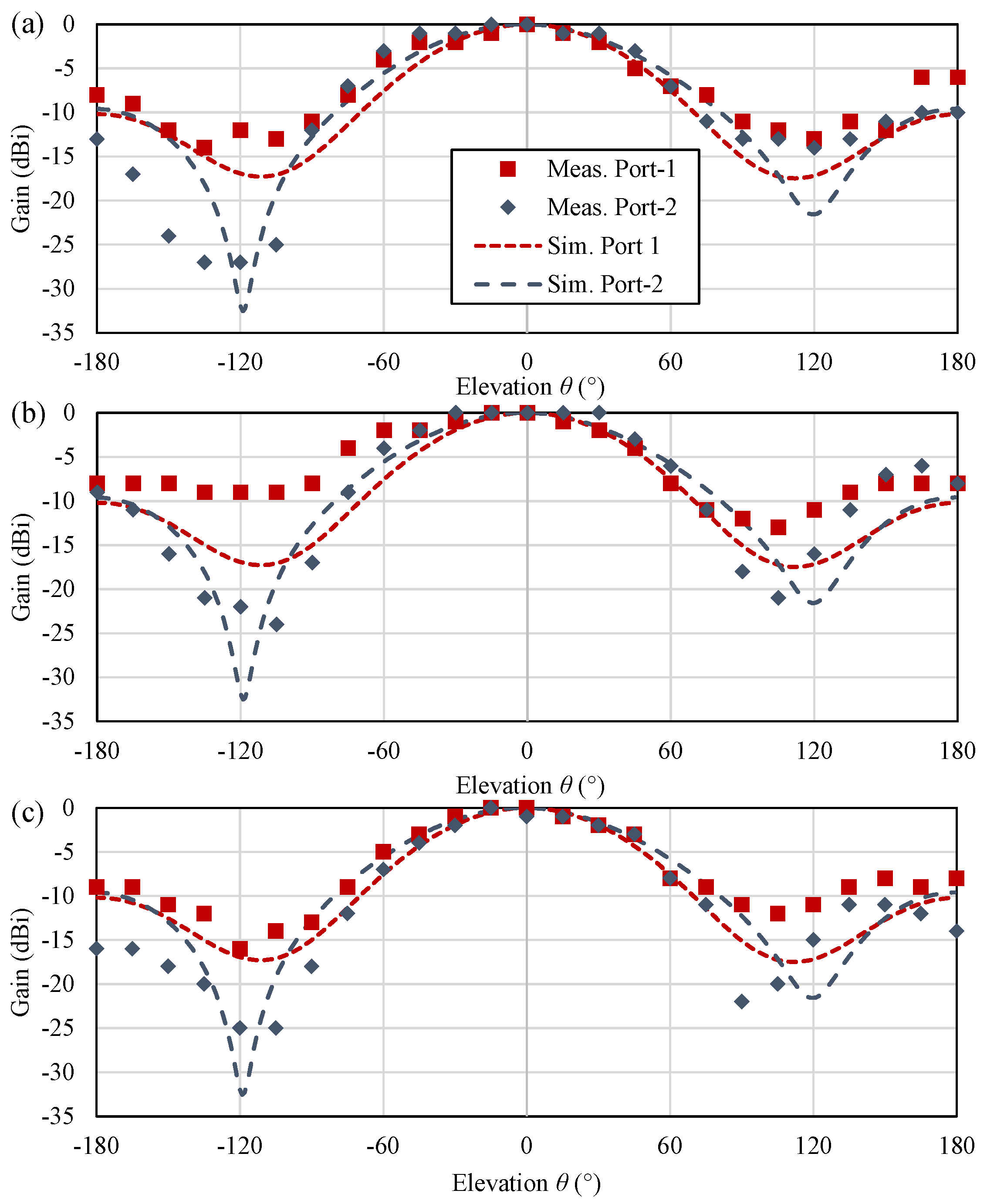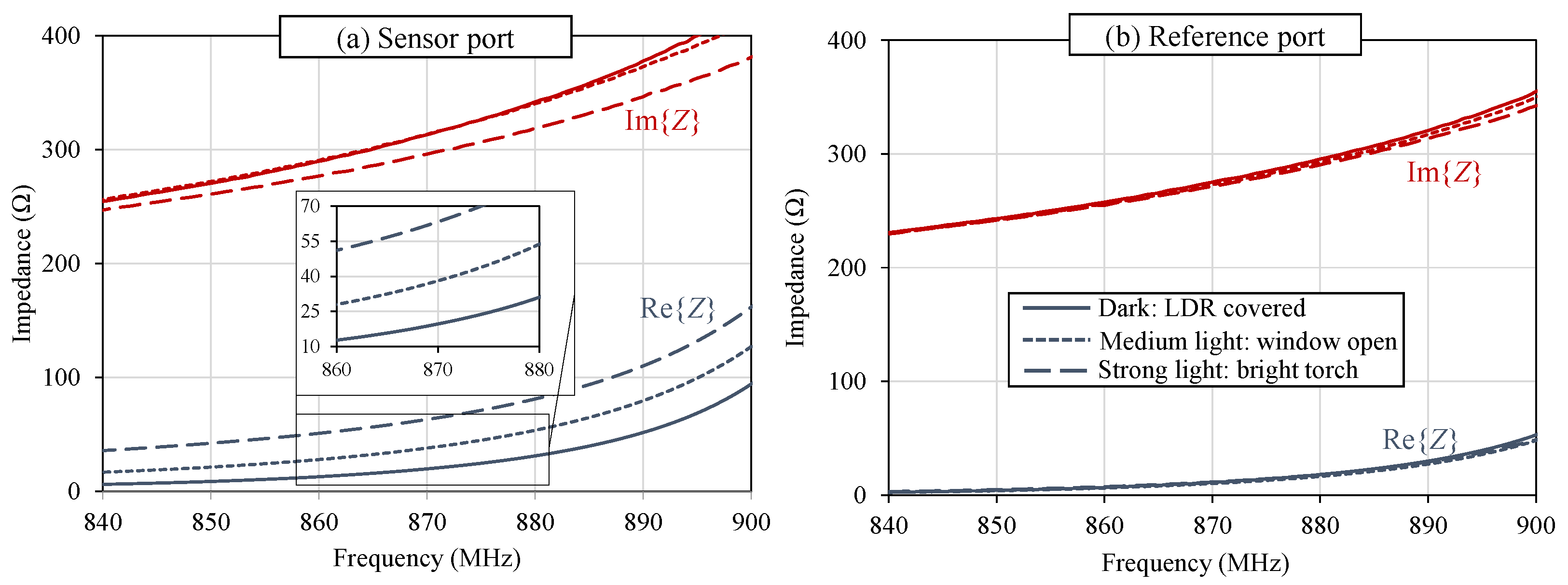Battery-Free Wireless Light-Sensing Tag Based on a Long-Range Dual-Port Dual-Polarized RFID Platform
Abstract
:1. Introduction
2. Differential RFID Sensing Tags
3. Long-Range RFID Sensing Antenna Design
- A differential complex Z realized using a feed with scalable geometry, to match the complex Z of different off-the-shelf RFID ICs or rectifiers;
- Similar gain patterns with orthogonal and high-purity polarization across both ports, to reduce the envelope correlation coefficient (ECC);
- High port-isolation to ensure the reference tag remains unaffected by the measurand modulating the sensor’s impedance and RSSI.
4. Sensor Tag Characterization
4.1. LDR RF Characterization
4.2. RFID Antenna Simulation and Measurements
4.3. Light-Sensing Differential RFID Tag
4.4. Discussion and Comparison
5. Conclusions
Author Contributions
Funding
Institutional Review Board Statement
Informed Consent Statement
Data Availability Statement
Conflicts of Interest
References
- Yang, L.; Zhang, R.; Staiculescu, D.; Wong, C.P.; Tentzeris, M.M. A Novel Conformal RFID-Enabled Module Utilizing Inkjet-Printed Antennas and Carbon Nanotubes for Gas-Detection Applications. IEEE Antennas Wirel. Propag. Lett. 2009, 8, 653–656. [Google Scholar] [CrossRef] [Green Version]
- Vital, D.; Volakis, J.L.; Bhardwaj, S. An Ultra-High-Frequency Wirelessly-Powered Smart Bandage for Wound Monitoring and Sensing Using Frequency Modulation. In Proceedings of the 2021 IEEE MTT-S International Microwave Symposium (IMS), Atlanta, GA, USA, 7–25 June 2021; pp. 331–334. [Google Scholar] [CrossRef]
- Manzari, S.; Occhiuzzi, C.; Nawale, S.; Catini, A.; Di Natale, C.; Marrocco, G. Humidity Sensing by Polymer-Loaded UHF RFID Antennas. IEEE Sens. J. 2012, 12, 2851–2858. [Google Scholar] [CrossRef] [Green Version]
- Tedjini, S.; Karmakar, N.; Perret, E.; Vena, A.; Koswatta, R.; E-Azim, R. Hold the Chips: Chipless Technology, an Alternative Technique for RFID. IEEE Microw. Mag. 2013, 14, 56–65. [Google Scholar] [CrossRef]
- Valenta, C.R.; Durgin, G.D. Harvesting Wireless Power: Survey of Energy-Harvester Conversion Efficiency in Far-Field, Wireless Power Transfer Systems. IEEE Microw. Mag. 2014, 15, 108–120. [Google Scholar]
- Wagih, M.; Weddell, A.S.; Beeby, S. Rectennas for RF Energy Harvesting and Wireless Power Transfer: A Review of Antenna Design [Antenna Applications Corner]. IEEE Antennas Propag. Mag. 2020, 62, 95–107. [Google Scholar] [CrossRef]
- El Matbouly, H.; Tedjini, S.; Zannas, K.; Duroc, Y. Chipless Sensing System Compliant With the Standard Radio Frequency Regulations. IEEE J. Radio Freq. Identif. 2019, 3, 83–90. [Google Scholar] [CrossRef]
- Costa, F.; Genovesi, S.; Borgese, M.; Michel, A.; Dicandia, F.A.; Manara, G. A Review of RFID Sensors, the New Frontier of Internet of Things. Sensors 2021, 21, 3138. [Google Scholar] [CrossRef] [PubMed]
- Scotti, G.; Fan, S.Y.; Liao, C.H.; Chiu, Y. Body-Implantable RFID Tags Based on Ormocer Printed Circuit Board Technology. IEEE Sens. Lett. 2020, 4, 1–4. [Google Scholar] [CrossRef]
- Casula, G.A.; Montisci, G.; Rogier, H. A Wearable Textile RFID Tag Based on an Eighth-Mode Substrate Integrated Waveguide Cavity. IEEE Access 2020, 8, 11116–11123. [Google Scholar] [CrossRef]
- Wagih, M.; Wei, Y.; Komolafe, A.; Torah, R.; Beeby, S. Reliable UHF Long-Range Textile-Integrated RFID Tag Based on a Compact Flexible Antenna Filament. Sensors 2020, 20, 3435. [Google Scholar] [CrossRef] [PubMed]
- Kutty, A.A.; Björninen, T.; Sydänheimo, L.; Ukkonen, L. A novel carbon nanotube loaded passive UHF RFID sensor tag with built-in reference for wireless gas sensing. In Proceedings of the 2016 IEEE MTT-S International Microwave Symposium (IMS), San Francisco, CA, USA, 22–27 May 2016; pp. 1–4. [Google Scholar] [CrossRef]
- Wagih, M.; Shi, J. Wireless Ice Detection and Monitoring using Flexible UHF RFID Tags. IEEE Sens. J. 2021, 21, 18715–18724. [Google Scholar] [CrossRef]
- Cook, B.S.; Cooper, J.R.; Tentzeris, M.M. An Inkjet-Printed Microfluidic RFID-Enabled Platform for Wireless Lab-on-Chip Applications. IEEE Trans. Microw. Theory Techniq. 2013, 61, 4714–4723. [Google Scholar] [CrossRef]
- Wang, J.; Chang, L.; Aggarwal, S.; Abari, O.; Keshav, S. Soil Moisture Sensing with Commodity RFID Systems. In Proceedings of the 18th International Conference on Mobile Systems, Applications, and Services, Toronto, ON, Canada, 15–19 June 2020; Association for Computing Machinery: New York, NY, USA, 2020; pp. 273–285. [Google Scholar] [CrossRef]
- Marrocco, G.; Mattioni, L.; Calabrese, C. Multiport Sensor RFIDs for Wireless Passive Sensing of Objects—Basic Theory and Early Results. IEEE Trans. Antennas Propag. 2008, 56, 2691–2702. [Google Scholar] [CrossRef] [Green Version]
- Wang, T.; Dai, S.; Liu, Y.; Ye, T.T. Battery-less Sensing of Body Movements through Differential Backscattered RFID Signals. IEEE Sens. J. 2022, 22, 8490–8498. [Google Scholar] [CrossRef]
- Occhiuzzi, C.; Parrella, S.; Camera, F.; Nappi, S.; Marrocco, G. RFID-Based Dual-Chip Epidermal Sensing Platform for Human Skin Monitoring. IEEE Sens. J. 2021, 21, 5359–5367. [Google Scholar] [CrossRef]
- Hester, J.G.D.; Tentzeris, M.M. Inkjet-Printed Flexible mm-Wave Van-Atta Reflectarrays: A Solution for Ultralong-Range Dense Multitag and Multisensing Chipless RFID Implementations for IoT Smart Skins. IEEE Trans. Microw. Theory Techn. 2016, 64, 4763–4773. [Google Scholar] [CrossRef]
- Wagih, M.; Hilton, G.S.; Weddell, A.S.; Beeby, S. Dual-Polarized Wearable Antenna/Rectenna for Full-Duplex and MIMO Simultaneous Wireless Information and Power Transfer (SWIPT). IEEE Open J. Antennas Propag. 2021, 2, 844–857. [Google Scholar] [CrossRef]
- Wagih, M.; Komolafe, A.; Hillier, N. Screen-Printable Flexible Textile-Based Ultra-Broadband Millimeter-Wave DC-Blocking Transmission Lines Based on Microstrip-Embedded Printed Capacitors. IEEE J. Microw. 2022, 2, 162–173. [Google Scholar] [CrossRef]
- Palmer, K.; van Rooyen, M. Simple broadband measurements of balanced loads using a network analyzer. IEEE Trans. Instrum. Meas. 2006, 55, 266–272. [Google Scholar] [CrossRef] [Green Version]
- Abdelnour, A.; Fonseca, N.; Rennane, A.; Kaddour, D.; Tedjini, S. Design of RFID Sensor Tag for Cheese Quality Monitoring. In Proceedings of the 2019 IEEE MTT-S International Microwave Symposium (IMS), Boston, MA, USA, 2–7 June 2019; pp. 290–292. [Google Scholar] [CrossRef]
- Caizzone, S.; Occhiuzzi, C.; Marrocco, G. Multi-Chip RFID Antenna Integrating Shape-Memory Alloys for Detection of Thermal Thresholds. IEEE Trans. Antennas Propag. 2011, 59, 2488–2494. [Google Scholar] [CrossRef] [Green Version]
- Shi, J.; Wagih, M.; Beeby, S. Highly Conductive Flexible Printed PEDOT:PSS films for Green Humidity Sensing Applications. In Proceedings of the 2022 IEEE International Conference on Flexible and Printable Sensors and Systems (FLEPS), Vienna, Austria, 10–13 July 2022; pp. 1–4. [Google Scholar] [CrossRef]









| (nH) | () | () | (pF) | (pF) | Meas. * | Calc. | |
|---|---|---|---|---|---|---|---|
| Dark (<1 Lux) | 2.0 | 2.0 | 40k | 2.1 | 1.3 | 3.55 − j59.8 | 3.08 − j38 |
| Office light (≈614 Lux) | 3.8 | 9 | 345 | 2.9 | 1.3 | 24.9 − j20.5 | 23.4 − j10.9 |
| Flashlight (>13,000 Lux) | 4.6 | 4 | 9 | 2.9 | 1.3 | 28.7 + j64.4 | 27 + j58.8 |
| Frequency (MHz) | Calculated Range | Measured Range |
|---|---|---|
| 868 | 17.4 m | 18 m (IC 1); 14 m (IC 2) |
| 915 | 18.0 m | - |
| Condition | Distance | Sensor RSSI | Ref. RSSI | Diff. RSSI |
|---|---|---|---|---|
| Dark (<1 Lux) | 0.5 m | −38 dB | −41 dB | 3 dB |
| Light (≈600 Lux) | 0.5 m | −39.8 dB | −41 dB | 1.2 dB |
| Dark (<1 Lux) | 1.1 m | −41 dB | −42 dB | 1 dB |
| Light (≈600 Lux) | 1.1 m | −42 dB | −42 dB | 0 dB |
| Dark (<1 Lux) | 1.5 m | −49.4 dB | −43.5 dB | −5.9 dB |
| Light (≈600 Lux) | 1.5 m | −52.8 dB | −44 dB | −8.8 dB |
| Antenna Design | Unloaded Read Range | Application | Sensor | Materials | Dimensions (cm) | |
|---|---|---|---|---|---|---|
| This work | Dual-pol. inductive microstrip patch | 14–18 m (1.5 m sensing range) | Light-sensing | Resistive: LDR | FR4 PCB with printed spacer | 16 × 16 × 1 |
| 2022 [17] | Dual RFID dipoles | 3 m (0.5 m sensing range) | Human activity tracking | Mechanical: stretchable antenna | Embroidered antenna on textile | 9 × 3 (individual) >9 × 7 (combined ) |
| 2021 [18] | Dual-pol. wire antenna | 0.6 m (measured); estimated 1.5 m using a more sensitive IC | Temperature sensing | Dielectric: thermal insulation | Flexible copper on silicone | 3.5 × 3.5 |
| 2012 [3] | Dual dipole antennas | 8 m (3.5 m calculated sensing range) | Humidity sensing | Lossy dielectric (resistive): PEDOT:PSS | Copper on Teflon | 4.8 × 5.8 × 0.4 |
| 2011 [24] | Dual-IC dipole antenna | 1.5 m | Thermal threshold sensing | Mechanical: shape- memory alloy | FR4 PCB | 8 × 5.8 × 0.6 |
Publisher’s Note: MDPI stays neutral with regard to jurisdictional claims in published maps and institutional affiliations. |
© 2022 by the authors. Licensee MDPI, Basel, Switzerland. This article is an open access article distributed under the terms and conditions of the Creative Commons Attribution (CC BY) license (https://creativecommons.org/licenses/by/4.0/).
Share and Cite
Wagih, M.; Weddell, A.S.; Beeby, S. Battery-Free Wireless Light-Sensing Tag Based on a Long-Range Dual-Port Dual-Polarized RFID Platform. Sensors 2022, 22, 4782. https://doi.org/10.3390/s22134782
Wagih M, Weddell AS, Beeby S. Battery-Free Wireless Light-Sensing Tag Based on a Long-Range Dual-Port Dual-Polarized RFID Platform. Sensors. 2022; 22(13):4782. https://doi.org/10.3390/s22134782
Chicago/Turabian StyleWagih, Mahmoud, Alex S. Weddell, and Steve Beeby. 2022. "Battery-Free Wireless Light-Sensing Tag Based on a Long-Range Dual-Port Dual-Polarized RFID Platform" Sensors 22, no. 13: 4782. https://doi.org/10.3390/s22134782
APA StyleWagih, M., Weddell, A. S., & Beeby, S. (2022). Battery-Free Wireless Light-Sensing Tag Based on a Long-Range Dual-Port Dual-Polarized RFID Platform. Sensors, 22(13), 4782. https://doi.org/10.3390/s22134782








